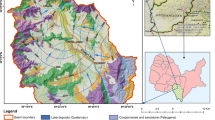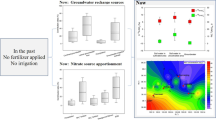Abstract
In the present study, 3-year (1997, 2008 and 2017) satellite images as well as different hydro-chemical parameters, nitrogen and oxygen isotopic composition of nitrate were used to examine the impacts of land use and land cover change on surface and groundwater quality. Through isotopic composition, sources of surface and groundwater pollutants were also elucidated. The results showed significant land use transition whereby land use changed from forest and bare land to agricultural land and built-up areas. A slight reduction in the size of areas covered by water bodies was also observed. Results indicate differences in nitrate concentration that mirror land use changes. Samples with elevated levels of nitrate above 10 mg/L were located near agricultural fields and areas with intensive livestock keeping activities. In groundwater, ẟ15N-nitrate and ẟ18O-nitrate ranged from 3.2‰ to 20.1‰ with a mean value of 11.7 ± 1.8‰ and from 2.1‰ to 12.0‰ with mean value of 5.4 ± 1.8‰, respectively. In surface water, ẟ15N-nitrate and ẟ18O-nitrate ranged from 2.4‰ to 19.3‰ with mean value of 4.9 ± 1.4‰ and from 1.5‰ to 21.9‰ with a mean value of 13.5 ± 2.8‰, respectively. Isotopic composition data suggest sources of nitrate in both ground and surface water dominated by synthetic and organic fertilizer application and to a lesser extent a natural soil nitrate source.







Similar content being viewed by others
References
APHA 2017 Standard methods for the examination of water and wastewater, American Public Health Association, American Water Works Association, Water Pollution Control Federation, and Water Environment Federation, USA.
Aravena R., Mayer B. 2009. Isotopes and processes in the nitrogen and sulfur cycles. Environ Isotopes Biodegrad Bioremed 203–246.
Aravena R, Evans M, Cherry JA (1993) Stable isotopes of oxygen and nitrogen in source identification of nitrate from septic systems. Groundwater 31(2):180–186
Bičík I., Kupková L., Jeleček L., Kabrda J., Štych P., Janoušek Z., Winklerová J. 2015 Land use changes in the Czech Republic 1845–2010: socio-economic driving forces, Springer.
Camara M, Jamil NR, Abdullah AFB (2019) Impact of land uses on water quality in Malaysia: a review. Ecological Processes 8(1):10
Chang CC, Kendall C, Silva SR, Battaglin WA, Campbell DH (2002) Nitrate stable isotopes: tools for determining nitrate sources among different land uses in the Mississippi river Basin. Can J Fish Aquat Sci 59(12):1874–1885
Chenini I, Farhat B, Ben MA (2010) Identification of major sources controlling groundwater chemistry from a multilayered aquifer system. Chem Speciat Bioavailab 22(3):183–189
Choi W-J, Han G-H, Lee S-M, Lee G-T, Yoon K-S, Choi S-M, Ro H-M (2007) Impact of land-use types on nitrate concentration and δ15N in unconfined groundwater in rural areas of Korea. Agr Ecosyst Environ 120(2–4):259–268
Cobbina S, Duwiejuah A, Quansah R, Obiri S, Bakobie N (2015) Comparative assessment of heavy metals in drinking water sources in two small-scale mining communities in northern Ghana. Intern J Environ Res Public Health 12(9):10620–10634
Coppin PR, Bauer ME (1996) Digital change detection in forest ecosystems with remote sensing imagery. Remote Sensing Rev 13(3–4):207–234
Dehnavi AG, Sarikhani R, Nagaraju D (2011) Hydro geochemical and rock water interaction studies in East of Kurdistan, NW of Iran. Int J Environ Sci Res 1(1):16–22
Deutsch B, Mewes M, Liskow I, Voss M (2006) Quantification of diffuse nitrate inputs into a small river system using stable isotopes of oxygen and nitrogen in nitrate. Org Geochem 37(10):1333–1342
Dong M, Cheng W, Li Z, Demopoulos GP (2008) Solubility and stability of nesquehonite (MgCO3·3H2O) in NaCl, KCl, MgCl2, and NH4Cl solutions. J Chem Eng Data 53(11):2586–2593. https://doi.org/10.1021/je800438p
Durka W, Schulze E-D, Gebauer G, Voerkeliust S (1994) Effects of forest decline on uptake and leaching of deposited nitrate determined from 15N and 18O measurements. Nature 372(6508):765
Elisante E, Muzuka AN (2016) Assessment of sources and transformation of nitrate in groundwater on the slopes of Mount Meru. Tanzania Environ Earth Sci 75(3):277
Elisante E, Muzuka AN (2017) Occurrence of nitrate in Tanzanian groundwater aquifers: a review. Appl Water Sci 7(1):71–87
Eppicha G. R. (2012).Source determination of anthropogenic NO3 in groundwater by analysis of δ 15 N, δ 18 O, and δ 11 B: a case study from San Diego county, California. Groundwater Resources Association of California, Fresno, CA, 13(3).
Ghiglieri G., Pittalis D., Cerri G., Oggiano G. 2012. Hydrogeology and hydrogeochemistry of an alkaline volcanic area: the NE Mt. Meru slope (East African Rift-Northern Tanzania). Hydrol Earth Sys Sci 16(2).
Granger J, Sigman DM (2009) Removal of nitrite with sulfamic acid for nitrate N and O isotope analysis with the denitrifier method. Rapid Commun Mass Spectrom 23(23):3753–3762
Hongoa PS (2014) The impact of population increase around Lake Babati. The Open University of Tanzania, Tanzania
Ilyas A, Sarwar T (2003) Study of trace elements in drinking water in the vicinity of Palosi drain, Peshawar. Pak J Biol Sci 6:86–91
Jahnen-Dechent W, Ketteler M (2012) Magnesium basics. Clin Kidney J 5(Suppl 1):i3–i14. https://doi.org/10.1093/ndtplus/sfr163
Kelly W, Panno S, Hackley K (2012) The sources, distribution, and trends of chloride in waters of Illinois. Bulletin (Illinois State Water Survey) no. 74.
Kendall C. 1998. Tracing nitrogen sources and cycling in catchments. Isotope tracers in catchment hydrology. Elsevier.
Kendall C., Aravena R. 2000. Nitrate isotopes in groundwater systems. Environmental tracers in subsurface hydrology. Springer.
Kendall C, Elliott EM, Wankel SD (2007) Tracing anthropogenic inputs of nitrogen to ecosystems. Stable Isotopes Ecol Environ Sci 2:375–449
Kitalika AJ, Machunda RL, Komakech HC, Njau KN (2017) Land-use and land cover changes on the slopes of Mount Meru-Tanzania. Current World Environment 13(3):331
Mayer B, Boyer EW, Goodale C, Jaworski NA, Van Breemen N, Howarth RW, Seitzinger S, Billen G, Lajtha K, Nadelhoffer K (2002) Sources of nitrate in rivers draining sixteen watersheds in the northeastern US: isotopic constraints. Biogeochemistry 57(1):171–197
Miserendino ML, Casaux R, Archangelsky M, Di Prinzio CY, Brand C, Kutschker AM (2011) Assessing land-use effects on water quality, in-stream habitat, riparian ecosystems and biodiversity in Patagonian northwest streams. Sci Total Environ 409(3):612–624
Mitsch WJ, Day JW, Gilliam JW, Groffman PM, Hey DL, Randall GW, Wang N (2001) Reducing nitrogen loading to the gulf of Mexico from the Mississippi river Basin: strategies to counter a persistent ecological problem: ecotechnology—the use of natural ecosystems to solve environmental problems—should be a part of efforts to shrink the zone of hypoxia in the Gulf of Mexico. Bioscience 51(5):373–388
Molina M, Aburto F, Calderón R, Cazanga M, Escudey M (2009) Trace element composition of selected fertilizers used in Chile: phosphorus fertilizers as a source of long-term soil contamination. Soil Sediment Contamination 18(4):497–511
Namugize JN, Jewitt G, Graham M (2018) Effects of land use and land cover changes on water quality in the uMngeni river catchment, South Africa. Physics and Chemistry of the Earth, Parts A/B/C 105:247–264
Nkotagu H (1996) Origins of high nitrate in groundwater in Tanzania. J Afr Earth Sc 22(4):471–478
Nur A, Ishaku JM, Yusuf SN (2012) Groundwater flow patterns and hydrochemical facies distribution using geographical information system (GIS) in Damaturu, Northeast Nigeria. Intern J Geosci 3(05):1096
Pantaleo P, Komakech H, Mtei K, Njau K (2018) Contamination of groundwater sources in emerging African towns: the case of Babati town. Tanzania Water Pract Technol 13(4):980–990
Pardo LH, Kendall C, Pett-Ridge J, Chang CC (2004) Evaluating the source of streamwater nitrate using δ15N and δ18O in nitrate in two watersheds in New Hampshire, USA. Hydrol Process 18(14):2699–2712
Ramesh R, Kumar KS, Eswaramoorthi S, Purvaja G (1995) Migration and contamination of major and trace elements in groundwater of Madras City. India Environ Geol 25(2):126–136
Rawat J, Kumar M (2015) Monitoring land use/cover change using remote sensing and GIS techniques: a case study of Hawalbagh block, district Almora, Uttarakhand, India. Egyptian J Remote Sensing Space Sci 18(1):77–84
Reid RS, Kruska RL, Muthui N, Taye A, Wotton S, Wilson CJ, Mulatu W (2000) Land-use and land-cover dynamics in response to changes in climatic, biological and socio-political forces: the case of southwestern Ethiopia. Landscape Ecol 15(4):339–355
Rock L, Mayer B (2004) Isotopic assessment of sources of surface water nitrate within the Oldman River basin, Southern Alberta, Canada. Biogeochemical investigations of terrestrial, freshwater, and wetland ecosystems across the globe. Springer.
Saana SBBM, Fosu SA, Sebiawu GE, Jackson N, Karikari T (2016) Assessment of the quality of groundwater for drinking purposes in the Upper West and Northern regions of Ghana. SpringerPlus 5(1):2001
Salvado V, Quintana X, Hidalgo M (2006) Monitoring of nutrients, pesticides, and metals in waters, sediments, and fish of a wetland. Arch Environ Contam Toxicol 51(3):377–386
Sandström K (1995) The recent lake Babati floods in semi-arid Tanzania—a response to changes in land cover? Geogr Ann 77(1–2):35–44
Tank DK, Chandel CS (2010) Analysis of the major ion constituents in groundwater of Jaipur city. Nature Sci 8(10):1–7
Tappan GG, Sall M, Wood EC, Cushing M (2004) Ecoregions and land cover trends in Senegal. J Arid Environ 59(3):427–462
Utom AU, Odoh BI, Egboka BC, Egboka NE, Okeke HC (2013) Estimation of subsurface hydrological parameters around Akwuke, Enugu, Nigeria using surface resistivity measurements. J Geophys Eng 10(2):025016
Wassenaar LI (1995) Evaluation of the origin and fate of nitrate in the Abbotsford aquifer using the isotopes of15N and18O in NO3−. Appl Geochem 10(4):391–405
WHO. 2011. Guidelines for drinking-water quality. World Health Organization: Geneva, Switzerland. Available: https://www.who.int/water_sanitation_health/dwq/chemicals/nitratenitrite2ndadd.pdf [216].
Widory D, Petelet-Giraud E, Négrel P, Ladouche B (2005) Tracking the sources of nitrate in groundwater using coupled nitrogen and boron isotopes: a synthesis. Environ Sci Technol 39(2):539–548
Xue D, Botte J, De Baets B, Accoe F, Nestler A, Taylor P, Van Cleemput O, Berglund M, Boeckx P (2009) Present limitations and future prospects of stable isotope methods for nitrate source identification in surface-and groundwater. Water Res 43(5):1159–1170
Yusuf K (2007) Evaluation of groundwater quality characteristics in Lagos-City. J Appl Sci 7(13):1780–1784
Acknowledgements
Professor Alfred N. N. Muzuka, who died during the course of this work—Alfred, you will always be remembered for your diligence and adherence to standards. We also thank the African Development Bank (AfDB) for a support given to the Nelson Mandela African Institution of Science and Technology (NM-AIST) from which this research benefited.
Author information
Authors and Affiliations
Corresponding author
Additional information
Publisher's Note
Springer Nature remains neutral with regard to jurisdictional claims in published maps and institutional affiliations.
Supplementary Information
Below is the link to the electronic supplementary material.
Rights and permissions
About this article
Cite this article
Mallya, C.L., Rwiza, M.J. Influence of land use change on nitrate sources and pollutant enrichment in surface and groundwater of a growing urban area in Tanzania. Environ Earth Sci 80, 111 (2021). https://doi.org/10.1007/s12665-021-09386-z
Received:
Accepted:
Published:
DOI: https://doi.org/10.1007/s12665-021-09386-z




